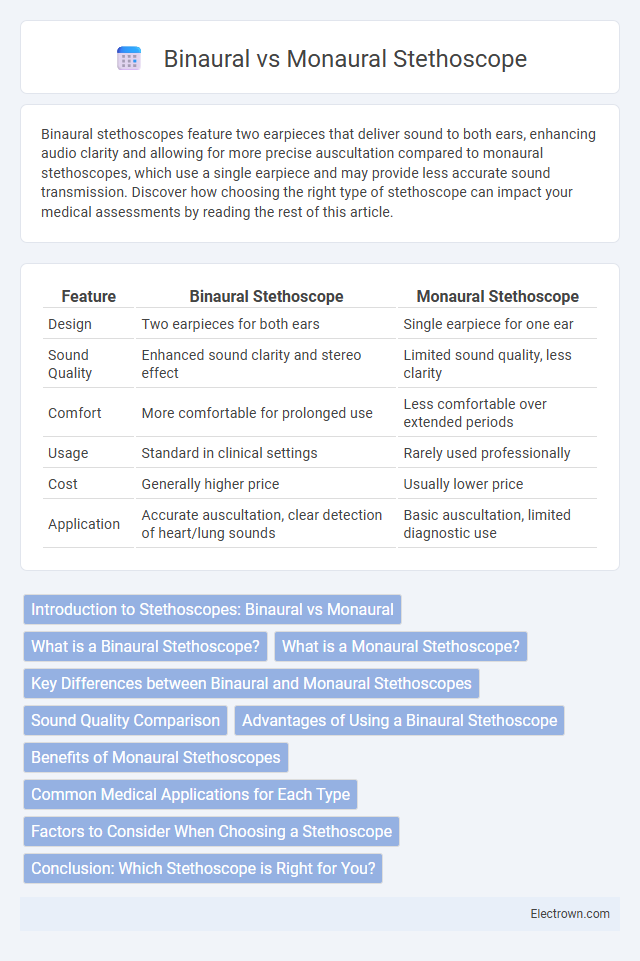Binaural stethoscopes feature two earpieces that deliver sound to both ears, enhancing audio clarity and allowing for more precise auscultation compared to monaural stethoscopes, which use a single earpiece and may provide less accurate sound transmission. Discover how choosing the right type of stethoscope can impact your medical assessments by reading the rest of this article.
Table of Comparison
| Feature | Binaural Stethoscope | Monaural Stethoscope |
|---|---|---|
| Design | Two earpieces for both ears | Single earpiece for one ear |
| Sound Quality | Enhanced sound clarity and stereo effect | Limited sound quality, less clarity |
| Comfort | More comfortable for prolonged use | Less comfortable over extended periods |
| Usage | Standard in clinical settings | Rarely used professionally |
| Cost | Generally higher price | Usually lower price |
| Application | Accurate auscultation, clear detection of heart/lung sounds | Basic auscultation, limited diagnostic use |
Introduction to Stethoscopes: Binaural vs Monaural
Binaural stethoscopes feature two earpieces connected by binaural tubing, offering enhanced sound clarity and stereo audio perception for accurate heart and lung auscultation. Monaural stethoscopes, with a single earpiece, provide basic acoustic feedback but lack the depth and noise isolation of binaural models. Healthcare professionals prefer binaural stethoscopes for detailed diagnostic auscultation due to improved comfort and sound quality.
What is a Binaural Stethoscope?
A binaural stethoscope features two earpieces connected by flexible tubing designed to deliver sound to both ears simultaneously, enhancing auditory clarity and reducing external noise interference. This type differs from monaural stethoscopes, which have a single earpiece that transmits sound to one ear, often resulting in less precise auscultation. Your choice of a binaural stethoscope improves diagnostic accuracy by allowing more detailed sound detection from the chest or other body areas.
What is a Monaural Stethoscope?
A monaural stethoscope features a single earpiece and a single tube, designed for basic auscultation with sound transmitted through one ear. It is typically less expensive and simpler in design compared to binaural stethoscopes, which have two earpieces for stereo sound transmission. Despite its limited auditory range, the monaural stethoscope remains useful in certain clinical settings for detecting heartbeats and breath sounds.
Key Differences between Binaural and Monaural Stethoscopes
Binaural stethoscopes feature two earpieces connected by flexible tubing, allowing for stereo sound perception and enhanced auscultation accuracy, while monaural stethoscopes have a single earpiece and transmit sound through one channel, often resulting in less precise sound localization. The binaural design improves your ability to detect subtle heart and lung sounds by delivering clearer, more balanced audio to both ears. Key differences include sound quality, comfort during prolonged use, and diagnostic effectiveness, with binaural stethoscopes being the preferred tool for modern medical professionals.
Sound Quality Comparison
Binaural stethoscopes deliver superior sound quality by utilizing dual earpieces that provide enhanced acoustic clarity and noise isolation compared to monaural stethoscopes with a single earpiece. The binaural design allows physicians to better distinguish subtle heart, lung, and vascular sounds, improving diagnostic accuracy. In contrast, monaural stethoscopes often produce lower fidelity audio, making it harder to detect faint or complex bodily sounds.
Advantages of Using a Binaural Stethoscope
Binaural stethoscopes offer enhanced acoustic clarity by using two earpieces, allowing healthcare professionals to detect subtle heart and lung sounds more accurately compared to monaural models. The dual-ear design improves noise isolation and auditory comfort, reducing listening fatigue during extended examinations. This increased auditory precision supports better diagnosis and patient outcomes in clinical settings.
Benefits of Monaural Stethoscopes
Monaural stethoscopes provide clear and direct sound transmission through a single earpiece, making them ideal for quick assessments and basic diagnostic use. Their lightweight design and ease of use enhance comfort, especially in fast-paced clinical environments. If you prioritize simplicity and cost-effectiveness, monaural stethoscopes offer reliable performance without the complexity of binaural models.
Common Medical Applications for Each Type
Binaural stethoscopes are widely used in clinical settings for comprehensive cardiovascular and respiratory assessments due to their superior sound quality and ability to isolate heart, lung, and bowel sounds. Monaural stethoscopes, while less common in modern practice, are still effective in basic medical examinations and are often preferred in educational settings for teaching auscultation techniques. Both types play crucial roles in diagnosing conditions like heart murmurs, lung infections, and intestinal obstructions, with binaural models offering enhanced acoustic clarity for detailed evaluations.
Factors to Consider When Choosing a Stethoscope
When choosing a stethoscope, consider sound quality and clarity, where binaural stethoscopes often provide superior acoustic performance by using dual earpieces to enhance auscultation. Comfort and fit are essential, as binaural models offer adjustable binaural tension and ergonomic eartips, whereas monaural stethoscopes may be lighter but less comfortable for extended use. Durability and price also weigh heavily, with binaural devices generally more expensive and robust, suitable for clinical professionals demanding precise diagnostics.
Conclusion: Which Stethoscope is Right for You?
Choosing between a binaural and monaural stethoscope depends on your specific medical needs and preferences, with binaural models offering superior sound clarity and noise isolation due to dual earpieces. Monaural stethoscopes, being simpler and often more affordable, may suit beginners or those needing basic auscultation. Your decision should weigh the importance of diagnostic accuracy against budget and ease of use in clinical settings.
Binaural vs Monaural Stethoscope Infographic

 electrown.com
electrown.com